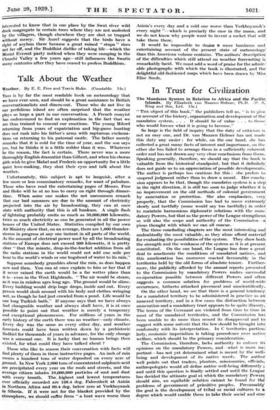Talk About the Weather
Weather. By E. E. Free and Travis Hoke. (Constable. 14s.)
THIS is by far the most readable book on meteorology that we have ever seen, and should be a great assistance to British conversationalists and diners-out. Those who do not live in our perfidious island are often surprised that the weather plays so large a part in our conversation. A French essayist has endeavoured to find an explanation in the fact that we are thus trained to conceal our emotions. The young Milord. returning from years of expatriation and big-game hunting does not rush into his father's arms with rapturous exclama- tions on returning to his paternal castle. The father merely. remarks that it is cold for the time of year, and the son says yes, but he thinks it is a little milder than it was. Whatever be the reason, the fact is certain. There never was a more thoroughly English dramatist than Gilbert, and when his chorus girls wish to give Mabel and Frederic an opportunity for a little quiet love-making, they shut their eyes and talk about the weather..
Unfortunately, this subject is apt to languish, after a few more or less comminatory remarks, for want of pabulum. Those who have read the entertaining pages of Messrs. Free and Hoke will be at no loss to carry on right through dinner- time. When some one makes the not uncommon remark that our bad summers are due to the amount of electricity projected into the air by broadcasting, they can at once state with authority that this is all bunkum. A single flash of lightning probably emits as much as 50,000,000 kilowatts, twice as much electricity as can be generated in all the power houses of the United States. Statistics compiled by our own Air Ministry show that, on an average, there are 1,800 thunder- storms in progress at any one instant in all parts of the world. As the amount of electrical power used by all the broadcasting stations of Europe does not exceed 300 kilowatts, it is pretty clear " that the minute, drop-in-the-bucket addition from all the radio stations in the world could not add one mile per hour to the world's winds or one hogshead of water to its rain."
Suppose somebody grumbles about the rain, as does happen now and then. You can at once explain to him or her that if it never rained the earth would be a far wetter place than it is—even in the West Highlands. " The air would be steam, as it was in rainless ages long ago. The ground would be slime,. Every building would drip huge drops, inside and out. Every person would slosh around with his body and clothes wringing wet, as though he had just crawled from a pond. Life would be one long Turkish bath." If anyone says that we have always had changeable weather and always shall have, it is at once possible to point out that weather is merely a temporary and exceptional phenomenon. For millions of years in the early history of the earth there was no weather—only climate. Every day was the same as every other day, and weather forecasts could have been written down by a prehistoric Zadkiel for thousands of years in advance, for the only change was a seasonal one. It is lucky that no human beings then existed, for what could they have talked about ?
Those who like to season their conversation with facts will find plenty of them in these instructive pages. An inch of rain means a hundred tons of water deposited on every acre of ground. In New York 2,000 tons of concentrated sulphuric acid are precipitated every year on the roofs and streets, and the average citizen inhales 10,000,000 particles of soot and dust with every breath. The highest and lowest temperatures ever officially recorded are 136.4 deg. Fahrenheit at Azizia in Northern Africa and 90.4 deg. below zero at Verkhoyansk in Siberia. If it were not for the blanket provided by the atmosphere, we should suffer from " a heat wave worse than Azizia's every day and a cold one worse than Verkhoyansk's every night "—which is precisely the case in the moon, and we do not know why people want to invent a rocket that wilt take them there.
It would be impossible to desire a more luminous and entertaining account of the present state of meteorology than this American volume contains. The authors' description of the difficulties which still attend on weather forecasting LS remarkably lucid. We must add a word of praise for the admir-' able photographs with which the book is illustrated, and the delightful old-fashioried maps which have been drawn by Miss Elise Seeds.








































 Previous page
Previous page